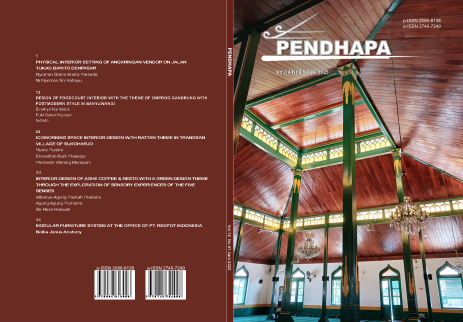Coworking Space Interior Design with Rattan Theme in Trangsan Village of Sukoharjo
DOI:
https://doi.org/10.33153/pendhapa.v14i1.5414Keywords:
Interior, Coworking space, SukoharjoAbstract
The interior design of a coworking space with a rattan theme in Trangsan Sukoharjo Village functions as a means of renting workspaces that are used jointly and openly with other users with flexible time usage. This design aims to create an interior design for a coworking space in Sukoharjo that can meet the needs of activities that are safe, comfortable and create a productive atmosphere. This design adopted several stages of the design process proposed by Kurtz. Kurtz's model of programming is programming on the qualitative rather than quantitative side. The basis of the design used is the function, ergonomics, technical, color, theme and style approaches. This design adopts a Bohemian design style with a rattan theme as the design base. The rattan theme gives a natural impression of the use of rattan characteristics applied to interior elements in the form of furniture, partitions and so on.Downloads
References
Blakenay, Justina. 2015. The New Bohemians: Cool and Collected Homes Hardcover. New York: Abrams.
Ching, Francis D. K., and Corky Binggeli. 2017. Interior Design Illustrated Fourth Edition.
J. Dransfield, N Manokaran. 1996. Sumber Daya Nabati Asia Tenggara 6. Gadjah Mada University Press.
Jackson, Denise, Hairong Shan, and Stephanie Meek. 2022. “Enhancing Graduates’ Enterprise Capabilities through Work-Integrated Learning in Co-Working Spaces.” Higher Education 84 (1): 101–20. https://doi.org/10.1007/s10734-021-00756-x.
Meindrasari, Dwi Koni, and Lestari Nurhayati. 2019. “Makna Batik Sidomukti Solo Ditinjau Dari Semiotika Sosial Theo Van Leeuwen.” WACANA, Jurnal Ilmiah Ilmu Komunikasi 18 (1). https://doi.org/10.32509/wacana.v18i1.718.
Sumarno, Dharsono, Guntur, Agung Purnomo, and Bagus Setyawan. 2019. “Rattan Batik: Local Wisdom-Based Rattan Furnitures Finishing Industry.” In SEWORD FRESSH 2019. EAI. https://doi.org/10.4108/eai.27-4-2019.2286919.
Sumarno, and Ersnathan Budi Prasetyo. 2022. “Soft Finishing: A Safe and Comfort Furnikids Design for Preschool Children.” Journal of Early Childhood Care and Education 4 (1): 23–30. https://doi.org/10.26555/jecce.v4i1.2471.
Sumarno, Sumarno, and Indarto Indarto. 2018. “Desain Show Room Bagi Para Perajin Rotan DS. Trangsan, Kec. Gatak, Kab. Sukoharjo.” Pendhapa 9 (2). https://doi.org/https://doi.org/10.33153/pendhapa.v9i2.2419.
Sumarno, Sumarno, Andi Tanra Tellu, and Agung Cahyana. 2022. “Split Waste from Rattan Industry? Crafted Product and Furniture Industry Fiber Bar.” International Journal of Health Sciences, 351–66. https://doi.org/10.53730/ijhs.v6ns4.5520.
Suptandar, J.Pamudji. 1982. Perancangan Tata Ruang Dalam (Interior Design). Jakarta: Penerbit PT Djambatan.
Trisnawati, Septiana, and Rahmanu Widayat. 2021. “Bohemian Luxury Style in the Interior Design of a Coffee House and Barista Training.” Pendhapa 12 (1): 1–12. https://doi.org/10.33153/pendhapa.v12i1.3871.
Weijs-Perrée, Minou, Jasper van de Koevering, Rianne Appel-Meulenbroek, and Theo Arentze. 2019. “Analysing User Preferences for Co-Working Space Characteristics.” Building Research and Information 47 (5): 534–48. https://doi.org/10.1080/09613218.2018.1463750.
Downloads
Published
Issue
Section
License
Copyright (c) 2023 Retno Pantini, Ersnathan Budi Prasetyo, Agung Purnomo

This work is licensed under a Creative Commons Attribution-ShareAlike 4.0 International License.
Authors who publish with Pendhapa agree to the following terms:
- Authors retain copyright and grant the journal right of first publication with the work simultaneously licensed under a Creative Commons Attribution License (CC BY-SA 4.0) that allows others to share the work with an acknowledgment of the work's authorship and initial publication in this journal.
- Authors are able to enter into separate, additional contractual arrangements for the non-exclusive distribution of the journal's published version of the work (e.g., post it to an institutional repository or publish it in a book), with an acknowledgment of its initial publication in this journal.
- Authors are permitted and encouraged to post their work online (e.g., in institutional repositories or on their website) prior to and during the submission process, as it can lead to productive exchanges, as well as earlier and greater citation of published work.

This work is licensed under a Creative Commons Attribution-ShareAlike 4.0 International License.









